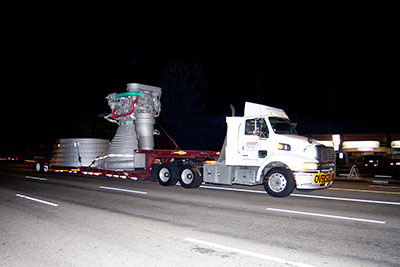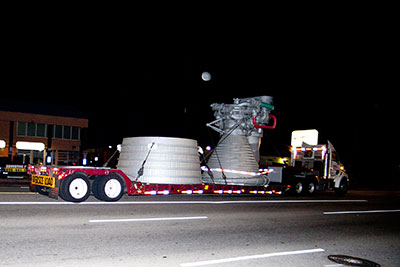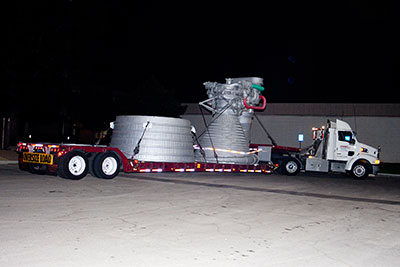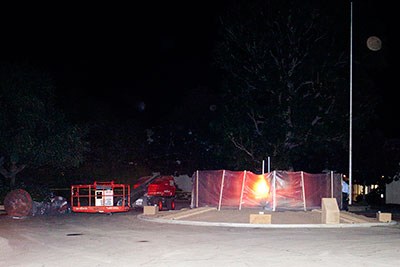|
Author
|
Topic: Rocketdyne Canoga Park plant (and F-1 display)
|
ApolloEra
Member Posts: 18
From: Sherman Oaks, CA, USA
Registered: Feb 2013
|
 posted 10-01-2013 03:29 AM
posted 10-01-2013 03:29 AM
   
Now that the Aerojet purchase of Rocketdyne is final, they are closing the storied Canoga Ave. facility in the Los Angeles suburbs where the F-1 and J-2 engines were built. The F-1 in front has been a San Fernando Valley landmark and source of local pride, which I still remember driving by as a kid 30+ years ago, not to mention a place of pilgrimage for space fans. They are moving it a few miles to the one facility that is still open. I will try to post some pics of the move. Early next week, it will be partially disassembled by Coast Machinery Movers, a company that once moved Air Force One from San Bernardino to Simi Valley, and installed the jet inside the Ronald Reagan Library.Then pending an oversize load permit from the city, a movers team will load the engine on a big-rig flatbed and haul it between 8 p.m. and midnight Wednesday from Aerojet Rocketdyne in Canoga Park to its new berth outside its plant in Chatsworth. The engine that could propel a Saturn V to speeds of more than 6,000 mph will be trucked at no faster than 25 mph, company officials say. The journey should take no longer than 40 minutes. |
mikej
Member Posts: 481
From: Germantown, WI USA
Registered: Jan 2004
|
 posted 10-02-2013 07:50 PM
posted 10-02-2013 07:50 PM
   
As of early afternoon on Oct. 2, the nozzle extension and engine mockup had been loaded on a flatbed trailing in preparation for the move. |
Robert Pearlman
Editor Posts: 42988
From: Houston, TX
Registered: Nov 1999
|
 posted 10-03-2013 03:39 PM
posted 10-03-2013 03:39 PM
   
collectSPACE Historic moon engine mockup takes short trip to new LA displayA mockup of a mighty moon engine took a short trip under moonlight Wednesday (Oct. 2), as it moved from its display of 35 years to a nearby outdoor pedestal in Los Angeles. The 19-foot-tall (5.8-meters) Apollo F-1 engineering model was partially disassembled and then trucked the 3.3 miles (5.3 km) from outside the Canoga Park factory where the massive engines were assembled in the 1960s to Aerojet Rocketdyne's facility in Chatsworth, California. The move preceded the company closing the plant by the end of the year. "We're moving the monument, the F-1, from that location because it's an important representation of our successful past," Brian Lariviere, the Aerojet Rocketdyne manager for the development of an upgraded version of the F-1 engine, said in an interview with collectSPACE. "We're moving it to our headquarters here, the Los Angeles headquarters of Aerojet Rocketdyne, to represent where we are going to go in the future." |
Robert Pearlman
Editor Posts: 42988
From: Houston, TX
Registered: Nov 1999
|
 posted 10-03-2013 04:28 PM
posted 10-03-2013 04:28 PM
   
Photos courtesy Ray Holt:  


|
Spacepsycho
Member Posts: 818
From: Huntington Beach, Calif.
Registered: Aug 2004
|
 posted 10-05-2013 12:25 PM
posted 10-05-2013 12:25 PM
   
I appreciate the photo credit but it was my mom Lilian and sister Desiree, who both live in the San Fernando Valley, who photographed the F-1 move. They met a wonderful woman who was in charge of the F-1 move for Aerojet, she told my sister that her father helped build all of the Apollo F-1 engines and it was like an old friend coming home. That said, I spoke with a gentleman who worked on all of the Apollo command modules in Downey, he told me about the CM SPS engines on stands that were being scrapped after the program was cancelled. He said the engines were sold for $1,000 each and one scrap dealer purchased all of them. There has to be just one of these engines in someone's garage. |
Robert Pearlman
Editor Posts: 42988
From: Houston, TX
Registered: Nov 1999
|
 posted 08-27-2016 07:45 AM
posted 08-27-2016 07:45 AM
   
Almost three years after its F-1 engine display was moved, the 61-year-old Rocketdyne Propulsion & Power plant in Canoga Park is now being demolished, reports the Los Angeles Daily News. For the past week, backhoes and front loaders have been ripping down the north side of the abandoned rocket engine plant during a demolition expected to take nine months to a year.The 46-acre complex, shuttered by Aerojet Rocketdyne a few years ago, is slated to be transformed by owner United Technologies Corp. into a $3 billion "sustainable urban neighborhood." Until then, the company and its developers will work with local and state agencies during an environmental cleanup that includes asbestos and soil removal and disposal of decades of contaminated concrete. |
cspg
Member Posts: 6210
From: Geneva, Switzerland
Registered: May 2006
|
 posted 08-27-2016 11:31 AM
posted 08-27-2016 11:31 AM
   
Did the American Pickers (History Channel) — or anybody else — visit the facility before the start of the demolition? Picking up bits and pieces to create lucites?  |
Robert Pearlman
Editor Posts: 42988
From: Houston, TX
Registered: Nov 1999
|
 posted 10-31-2016 11:40 AM
posted 10-31-2016 11:40 AM
   
From NASA's History Office: UTC [United Technologies Corporation] is seeking a highly-qualified professional curator/expert to spearhead an important interpretive program for commemoration of the former Rocketdyne Canoga Park plant (in the Canoga Park community of Los Angeles, California) in the history of manned space flight, with emphasis on the rockets and propulsion systems manufactured on-site. This commemorative effort is required as part of a mitigation program, which was certified as part of the documentation prepared pursuant to the California Environmental Quality Act (CEQA) to evaluate potential environmental impacts of a proposed Soil Management Plan at the site. Please review and respond to the position description in the attached request for curator announcement. |
Fra Mauro
Member Posts: 1587
From: Bethpage, N.Y.
Registered: Jul 2002
|
 posted 11-02-2016 05:58 AM
posted 11-02-2016 05:58 AM
   
I'm glad they are saving the engines but there is still something a little sad about another Apollo historic site being turned into a "sustainable urban neighborhood." Forgive the musings of a history geek. |
Robert Pearlman
Editor Posts: 42988
From: Houston, TX
Registered: Nov 1999
|
 posted 03-20-2017 12:27 PM
posted 03-20-2017 12:27 PM
   
Heavy machinery has just about leveled the old Rocketdyne office and rocket engine manufacturing complex on Canoga Avenue in the West Valley, reports the Los Angeles Daily News. You could argue that the sprawling complex between Victory Boulevard and Vanowen Street qualified as a national treasure. The engines developed there powered everything from early intercontinental ballistic missiles to the Space Shuttle. And the company is still heavily involved in the nation's space exploration from its De Soto complex.Former Rocketdyne engineer Bill Vietinghoff has fond memories of those glory days. "Oh, it was a beautiful place," he said of the old complex. "A lot of people who worked there over the years were sad to see it go. A lot of the astronauts (who) came through Canoga Park, they wanted to have reassurance that the engines they were going to sit on were reliable." |
















